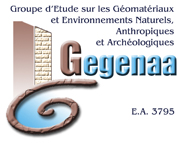Contribution of airborne LIDAR to the understanding of hydrosystems - Example of the Montagne de Reims
Apport du LIDAR aéroporté à la compréhension des hydrosystèmes - Exemple de la Montagne de Reims
Résumé
Airborne LiDAR is mainly used in archaeogeography under forest cover and in geography to reconstruct the practices of societies on the land and for the hydrogeomorphological approach in river corridors. However, the hydrosystems and anthropogenic forcing of the interfluves of the Grand Est region remain understudied, despite a satisfactory LiDAR coverage. The Montagne de Reims, corresponding to the eastern end of the Île-de-France cuesta, is used as an experimental site to characterize, using the LiDAR approach, both the structure of the hydrosystem and its evolution during the Holocene. This is a singular area (surface of 250 km²) which paradoxically has a high potential for heritage valorization, but is mainly conditioned by private forests, limiting its access and understanding. The approach consists of cross-referencing LiDAR data with a multi-criteria and multi-scalar spatial analysis using GIS, on several time scales (diachronic vision), with the experimental field approach. Processing a geodatabase not only allows us to discriminate between hydrosystem morphologies according to their genetic, historical and hydrodynamic criteria, but also to understand their spatial organization. It shows that the hydrosystem is the result of a long, multi-phase history. The parameters structuring its spatial organization are part of an overlap of scales. The geological scale (Paleogene deposit conditions) conditions aquifer disparities from east to west. The Quaternary explains the opposition between north and south slopes by controlling the degree of valley incision and geomorphological processes (landslides, karstification). On a historical scale, human and climatic forcings condition hydrological disparities between plateaus and valleys. Finally, a conceptual model of the current hydrosystem of the Montagne de Reims is proposed.
Le LiDAR aéroporté est principalement utilisé en archéogéographie sous couverture forestière et en géographie pour restituer les pratiques des sociétés sur le territoire et pour l’approche hydrogéomorphologique dans les corridors fluviaux. Mais les hydrosystèmes et le forçage anthropique des interfluves du Grand Est restent peu étudiés malgré une couverture liDAR satisfaisante. La Montagne de Reims, correspondant à la terminaison orientale de la cuesta d’Île-de-France est utilisée comme atelier expérimental pour caractériser, par l’approche LiDAR, d’une part la structure de l’hydrosystème et d’autre part son évolution durant l’Holocène. C’est un espace singulier (surface de 250 km²) paradoxalement à fort potentiel de valorisation patrimoniale mais conditionné majoritairement à la forêt privée, limitant son accès et sa connaissance. La démarche consiste à croiser les données LiDAR à une analyse spatiale multicritères et multiscalaire sous SIG, à plusieurs échelles de temps (vision diachronique), avec l’approche expérimentale de terrain. Le traitement d’une géodatabase permet non seulement de discriminer les morphologies de l’hydrosystème selon des critères génétiques, historiques et hydrodynamiques mais aussi de comprendre leur organisation spatiale. Il montre que l’hydrosystème résulte d’une longue histoire polyphasée. Les paramètres structurant son organisation spatiale s’inscrivent dans un emboitement d’échelle. L’échelle géologique (conditions de dépôt du Paléogène) conditionne les disparités aquifères d’est en ouest. Le Quaternaire explique l’opposition entre les versants nord et sud en commandant le degré d’incision des vallées et les processus géomorphologiques (mouvements de terrain, karstification). À l’échelle historique, les forçages humain et climatique conditionnent les disparités hydrologiques entre les plateaux et les vallées. Enfin, un modèle conceptuel de l’hydrosystème actuel de la Montagne de Reims est proposé.
Fichier principal
 hydrosysteme_de_la_montagne de_reims_2024_julien_berthe.pdf (44)
Télécharger le fichier
hydrosysteme_de_la_montagne de_reims_2024_julien_berthe.pdf (44)
Télécharger le fichier
| Origine | Fichiers produits par l'(les) auteur(s) |
|---|

